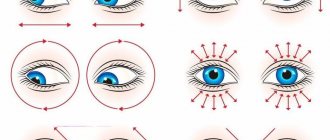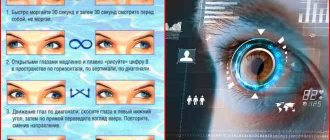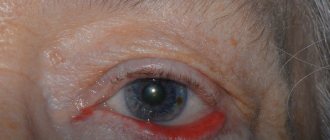Exercise to improve blood circulation in the eyes
articles Loading...
99 people out of 100 eyes experience oxygen starvation. This also makes the eyes weak, tired and not shiny enough.
99 people out of 100 eyes experience oxygen starvation. This also makes the eyes weak, tired and not shiny enough.
To help this problem, you can perform special breathing exercises. Significantly relieve the symptoms of eye fatigue by simply ventilating the room.
Breathing exercise to increase blood circulation in the eyes N1
1.Standing, feet together, toes apart, arms along the body.
2.Take a full breath. Hold your breath as you inhale, not allowing a single particle of air to escape through your nose or mouth. Close your eyes.
3. Bend forward so that your head is below heart level. You can bend your knees slightly. There should be no tension in the body. The blood flows directly to the head and eyes. This will be oxygenated blood. The eyes remain closed.
4.Remain in this position for a count of 5. Gradually increase the hold of this pose for a count of 15.
5.Calmly and slowly straighten up to the starting position.
6. Also calmly and slowly exhale completely through your mouth.
7.Repeat the exercise again.
Please note that the blood flow to your head may make you feel dizzy. The more often you hold your breath for at least 10 seconds, the faster you can get rid of this dizziness. But people suffering from cardiovascular diseases should be especially careful when practicing breath-holding.
At first, they are allowed to do this only without bending over. The amplitude of the head tilt should be increased gradually, without stopping for a second to monitor your condition.
Blood circulation in the tissues of the eyes increases. Do this eye cleansing with breathing at least 10 times throughout the day.
Sometimes, to prevent fatigue, it is enough to go out the door and ventilate the room.
Breathing to increase blood circulation in the eyes N2
1. The starting position is the same.
2.Take a deep breath and hold your breath as you inhale.
3. Bend at the waist and lean as close to the floor as you can. When your head is down, close your eyes.
4. When closing your eyes, squeeze them as tightly as possible. Then open wide.
5. All the time that you hold your breath while inhaling for a count of 10 to 15, open and close your eyes in this way.
6.Calmly straighten up, returning to the starting position.
7. Exhale vigorously and completely through your mouth.
9.Repeat the exercise again.
After doing these exercises, you will be surprised at how quickly your eyes will feel relief.
Relaxation exercise
Place your feet apart (so that it is comfortable) and begin to sway, like a bear, from side to side. Swing your whole body, head and arms in one direction or the other with rhythmic movements.
To the imaginary melody of a waltz, swing from side to side, first one leg, then the other.
This is the most beneficial relaxation movement that exists. It will relax your brain, eyes, neck and spine. This exercise stimulates blood circulation in the neck and eyes, and increases the sensitivity of all parts of the retina.
Tired eyes should not be overstrained, forcing them to continue working. If you feel tension in your eyes, then give them a rest: revive them by rinsing, then close them for a few minutes and shade them with your palms.
For rinsing, it is better to use tea leaves rather than eye drops. Simply running water or water straight from the tap is also suitable for this purpose.
Water poured into a cup quickly becomes contaminated, which can cause eye irritation or even cause infection.
Rinsing perfectly tones the eyes, relieves fatigue, and improves their blood supply. It can be used for any visual fatigue. You can continue working immediately after washing.
There are several ways to wash your eyes; we will present here the two simplest ones.
First.
Fill handfuls with cold water and splash the water into your wide open eyes. Repeat several times.
Second.
Fill a wide container with cold water. Place your face in the water without closing your eyes. After just a few attempts this will not cause any discomfort. Keep your face submerged while holding your breath. The eyes remain wide open all the time.
It should be borne in mind that the functioning of the eyes largely depends on the state of affairs throughout the body, primarily on the state of the nervous system and metabolism. Therefore, along with eye exercises, it is necessary to maintain the overall health of the body. published by econet.ru If you have any questions on this topic, ask them to the specialists and readers of our project here
PS And remember, just by changing your consciousness, we are changing the world together! © econet
Source: //medana-st.ru/diagnostika-i-lechenie/zaryadka-dlya-uluchsheniya-krovoobrashheniya-v-glazah.html
Symptoms
The main symptom is redness of the eye in which the vessel has burst. This is what most often brings a person to the clinic. The redness may be pinpointed (if one vessel has ruptured and the hemorrhage is small), or the entire eye may turn red if there are several ruptured capillaries or the bruise is large.
Other symptoms depend on the cause of hemorrhage and the part of the eyeball where the blood spilled. The naked eye can only notice those capillary ruptures that occur in the anterior part of the eye. But most of the eyeball is hidden in the skull and there are also vessels there that can burst. Let's look at the main locations of hemorrhages in the eye.
Retinal hemorrhage is perhaps the worst option. As you know, the retina is the nervous tissue that lines the inside of the eye and provides us with vision. Hemorrhage into this nerve sheath shuts off part of it from the visual process. And, if the vessels there burst regularly, then this gradually leads to a decrease in visual acuity and even complete blindness. Most often, the cause of such bruises is arterial hypertension, diabetes mellitus, and retinal vascular diseases. In this case, blurred vision occurs, “spots” appear before the eyes, and blind spots appear in the field of vision. There are no other signs. Diagnosis can only be made using an ophthalmological examination of the fundus.
Ophthalmoscopy (examination of the fundus of the eye) allows you to establish with 100% accuracy a hemorrhage in the retina and determine its cause
Hemorrhage into the orbit - this is possible, for example, due to injury. Blood pours into the retrobulbar fatty tissue, which leads to the appearance of exophthalmos (bulging eyes). At the same time, periorbital edema and bruising (traces of injury) can be observed; the patient complains of pain, inability to move the eye, and double objects when looking.
Hemorrhage into the vitreous body - the main part of the eye is filled with a transparent formation, which is called the vitreous body, it allows light rays to pass through and focus on the retina. If the transparency of this formation disappears (for example, with hemorrhage), then, naturally, vision also suffers. It is most often observed with traumatic injuries. This is a serious injury that requires specialized ophthalmic care.
Hemorrhage into the anterior chamber, also called hyphema, can be observed in various conditions, most often glaucoma and trauma. Blood collects in the lower part of the front surface of the eye, which is visible to the naked eye. As a rule, no special treatment is required - the blood resolves within 7-10 days, but in severe cases even surgical ophthalmological care cannot be ruled out.
Hemorrhage into the sclera and conjunctiva - it is this localization of bruises that is most often observed, because it is immediately visible. Any of the above reasons can lead to this: a surge in pressure, dry eye syndrome, and inflammatory ophthalmological pathology.
If you go to see a doctor, you need to talk in detail about what is bothering you. You can’t limit yourself to a simple “a blood vessel burst in the eye.” You need to detail what you did, when this happened, what other symptoms it was accompanied by, for example, severe headache, tinnitus, etc., whether this happened for the first time or has already happened, do you have other symptoms of increased bleeding, what diseases do you have and your close relatives, what medications you are taking, whether your vision has worsened. All these details will help the specialist quickly find the cause of your symptoms and, possibly, save not only your vision, but also your life.
Video broadcast about hemorrhage in the eyes:
how to improve blood circulation in the eyes? | Beauty | Medicine and health
Open theme in windows
- If this is related to this, then what medications or vitamins are there to improve blood circulation? Specifically for the eyes. I also wanted to ask, did Strix vitamins with blueberries help anyone? Were there any improvements?
- What is “connected with this” for you? Emoxipine - for blood circulation (it stings a lot, but it helps). Vitamins - Mertelene forte (expensive, it helps).
- I have improved. Every fall I take Phezam, Capilar, etc. - 3-4 months. Every spring - fish oil + vitamins for the eyes. I inject myself with B6 and B12 twice a year. I regularly use Emoxipin and periodically Quinax. I don’t know what exactly helped, I think Phezam + drops. It’s just that the result is very good, I really surprised the doctor.
- thank you. Phezam are drops? And how did you feel the improvement? What was your vision like? In the dark (twilight) did you see no worse? I have this too.
- I read about mertelene, I liked the instructions. But more than a thousand for 2 weeks (in terms of quantity it turns out) is a little expensive... you have to drink it, as it is written, for 3 months. Are these drops Emoxipin? Did it help you?
- Phezam (Capilar) is a tablet for improving cerebral circulation. See what I found about it: Special instructions The results of clinical studies have established that the drug Phezam helps to increase visual acuity, improves the functional state of the retina and hemodynamics of the eye. An increase in blood flow velocity in the arteries of the eye after a course of taking Phezam indicates an improvement in blood supply to the membranes of the eye. It is recommended to use the drug Phezam in the treatment of patients with dystrophic diseases of the retina (in particular with age-related macular degeneration). The combination of vasoactive (cinnarizine) and metabolic (piracetam) components of the drug Phezam allowed the drug to be used in a number of clinical studies to improve the effectiveness of existing methods of treating functional and organic lesions visual-nervous apparatus of the eyes in children and with the aim of stabilizing the achieved visual functions. Recommendations for the use of the drug Fezam in pediatric practice (as part of complex therapy) are: partial atrophy of the optic nerve of various origins; moderate and high myopia; post-traumatic, myopic and hereditary retinal dystrophy; amblyopia of various origins (including in combination with organic lesions of the central parts of the visual analyzer). In case of mild to moderate renal failure (creatinine clearance less than 60 ml/min), the therapeutic dose should be reduced or the interval between doses of the drug should be increased. In patients with liver function disorders, it is necessary to monitor the content of liver enzymes. Alcohol should be avoided while taking Phezam. Phezam should be prescribed with caution in case of increased intraocular pressure. The drug can cause a positive reaction in athletes during a doping test, and it is also possible to change the results of determining radioactive iodine ( the dyes in the capsule shell contain iodine). Effect on the ability to drive vehicles and operate machinery. While taking the drug Phezam, you should be careful when driving vehicles and working with machines and equipment. //www.e-apteka.ru/doc/Vidal_docs/drug_info_24221 .aspEmoxipin (Emoxy-optic) - drops. Quinax - also drops (don’t be alarmed that they are anti-glaucoma - these are vitamins). Vision has not gotten better, it’s impossible (it’s -9 and -12, I have complex high-degree myopic astigmatism) .On an ultrasound of the eyes they saw that blood circulation had become better. Twilight vision is not very good, but mine is hereditary, and in general this is more common in women. I noticed that the “brightness” has improved and my eyes no longer get tired of the computer. And the ophthalmologist is pleased that There are no changes - neither in the fundus, nor in pressure, nor in the retina (with my vision this is almost a miracle).
- I don’t drink ours, but I definitely drink fish oil, lute + zeaxanthin + blueberries. There was no improvement from ours at all. In the morning I couldn’t open my eyes + midges appeared. I’ve been taking vitamins for less than a month, my eyes at the computer don’t get tired, the “midges” have become much smaller + I’m drinking ginkgo biloba (improves cerebral circulation).
- Have you been to the doctor? There are at least 3 reasons for the “midge” and 2 of them are serious, and the 3rd is age-related and cannot be removed by anything.
- Emoxipin is a drop that helps me (with my problems) best. Maybe you should still visit a doctor and find out the diagnosis? What blood circulation do you want to improve? And for what? There are a lot of drops, vitamins and medicines for the eyes...
Source: //eva.ru/beauty/messages-2785834.htm
Strengthening eye blood vessels: the best medications, folk recipes and vitamins
The eye is the main sensory organ through which a person receives up to 90% of information from the surrounding world.
Many have encountered the phenomenon of “red eye” syndrome, when the sclera turns red. The cause of vascular rupture is the fragility and fragility of the vascular wall, so strengthening the blood vessels is an important link in treatment.
Visual analyzer device
Based on the structure of the eyes, they can be classified as the most complex optical devices. The organ is located symmetrically in special receptacles of the skull - the eye sockets. It consists of many structures: the visual-nervous apparatus, the choroid, the dioptric system. All elements are enclosed in a durable outer capsule.
The choroid of the eye is located between the sclera and the retina. The vessels feeding the eye are numerous; they branch into smaller formations - capillaries, which form anastomoses with each other and gather into a dense vascular network.
The proper functioning of these structures depends on how blood is delivered to all parts of the eye. Normally, the vascular network does not penetrate the tunica albuginea.
Red eye syndrome occurs either when blood vessels dilate or because of hemorrhage, when the thin walls of the capillaries burst. All actions aimed at strengthening the blood vessels of the eyes should begin with identifying the causes of the pathology.
Many diseases directly affect the strength of the vascular wall: they increase its permeability and reduce its elasticity. Red veins or a diffuse spot on the white of the sclera is a signal of trouble in the blood supply system of the eyeball
Diseases of the choroid are severe, and given the rich innervation of these structures, with severe pain.
Causes of red eyes
Redness of the tunica albuginea often appears when some part of the eye is inflamed with the involvement of blood vessels in the pathological process. They fill with blood and expand, causing the sclera to become stained.
The mechanism of local swelling of blood vessels comes down to the effect on them of inflammatory mediators (histamine, serotonin), which can relax the vascular wall. Infectious agents are viruses, bacteria, fungi, protozoa that cause keratitis, blepharitis, stye, purulent lesions of the eyelid. An early symptom of these inflammatory diseases is red eyes.
Allergic eye damage
The anatomical and physiological characteristics of the organ of vision require constant contact with allergens, which are contained in large quantities in the surrounding air.
Allergic inflammation occurs when a foreign substance (antigen) enters the sensitive mucous membrane of the eye - the conjunctiva. The released biologically active substances (histamine, bradykinin) increase vascular permeability and cause their dilation.
Diseases of the eyeball
Sometimes hemorrhages are the first sign of the development of serious eye diseases.
Underestimation of this symptom can lead to serious complications, including loss of vision:
- Retinal disinsertion.
- Retinal vein blockage.
- Eye tumors.
- Inflammation of various structures.
Injections of blood vessels or the appearance of a capillary network on the sclera of the eyes can cause:
- visual fatigue (TV, computer),
- excessive alcohol consumption,
- lack of sleep,
- physical action - when a blow to the area of the eyeball occurs, rupture of blood vessels and hemorrhage under the conjunctiva of the eye occurs,
- eye contusions due to head injuries,
- chemical exposure - a negative effect on the eye of irritating substances at high concentrations in the atmosphere (chlorine, sulfur, asbestos and others),
- foreign body entering the eye,
- Violations of the rules for wearing contact lenses (wrongly chosen, contaminated).
Important! Hemorrhages in the eyes occur quite often in a person’s life and are not a sign of a serious illness if there are no other symptoms (pain, inflammation, blurred vision). But long-term disruption of the blood supply to the eye structures leads to disruption of their functions.
Causes of choroid fragility
The vessels of the eye are part of the general circulatory system of the human body. Pathological processes leading to changes in the strength and elasticity of the vascular wall due to diseases or age-related changes fully apply to them.
https://www.youtube.com/watch?v=nJbs89TFFYQ
Many diseases affect the strength of the vascular wall: under the influence of various unfavorable factors, its permeability and elasticity increase. These include pathologies of the hematopoietic system, diabetes mellitus, and pressure surges due to hypertension.
Hemorrhages in the eyes due to systemic diseases are caused by:
- Reduced blood clotting (hemophilia), long-term use of blood thinning medications - anticoagulants and antiplatelet agents.
- Pathological fragility of blood vessels: connective tissue diseases (lupus erythematosus, autoimmune vasculitis), atherosclerosis, diabetes mellitus. Hypovitaminosis of vitamins C, K, P.
- Increased arterial and venous pressure with hypertension, with intense physical activity, efforts in women during childbirth, with suffocation, vomiting. In older people, blood vessels in the eyes can burst when bending over, coughing, straining, or constipation.
- In babies, strong crying leads to an increase in the intracapillary pressure of the eyes, they become filled with blood and become visible on the whites.
Methods for strengthening eye blood vessels
If it turns out that the main cause of hemorrhages is weak blood vessels, first of all care should be taken to ensure that the body receives sufficient amounts of vitamins C, K, P, A, and E along with food.
Drug treatment
Systemic administration of vasodilator drugs is indicated for concomitant diseases. You can strengthen damaged blood vessels with the help of vitamin complexes, vascular preparations, and eye drops.
Vitamins:
- C – helps strengthen blood vessels, takes part in hematopoiesis.
- P - reduces the fragility and fragility of capillaries, reduces the permeability of the vascular wall.
- K – regulates the biosynthesis of proteins involved in blood clotting.
- A – is necessary for the normal functioning of the retina.
- E – accelerates metabolic processes.
Lutein is a combined vitamin complex. Contains blueberry extract, vitamins C, E, A, trace elements zinc, copper, iron.
Optix - tablets contain lutein, beta-carotene, vitamins C, E.
Complivit Oftalmo - contains carotenoids, lutein, folic acid, a complex of vitamins: A, E, C, B1, B6, B12, minerals - selenium, zinc, copper.
Vitamins for the eyes are prescribed when there is increased stress on the organ of vision, to improve metabolic processes, stabilize cell membranes and strengthen blood vessels.
Eye drops
Taurine – reduces intraocular pressure, normalizes blood circulation. Used in the form of eye drops, 1-2 drops 4 times a day.
Oftan-Kataprom - multi-component eye drops dilate blood vessels and improve ocular blood circulation. Emoprox, Emoksipin, Emoksi-Optic (analogs) – have an angioprotective effect and can remove a blood clot.
Increases tissue resistance to oxygen deficiency. They strengthen the vascular wall. Therapy is aimed at resolving intraocular hemorrhages.
Hemorrhages vary in severity and size of the affected segment. It is possible to limit yourself to instilling eye drops only in mild cases.
Traditional methods
The use of folk remedies for eye hemorrhages is limited. Inept intervention can lead to irreparable consequences.
You can make contrasting eye baths: prepare two deep bowls - one with warm, the other with cool water. After immersing your face in a bowl of warm water, open and close your eyes several times, and do the same manipulation in a bowl of cold water.
Hardening with ice cubes. Infusion of chamomile inflorescences - a glass of boiling water per tablespoon - leave for 30 minutes. Pour into an ice tray. After freezing, apply to closed eyelids for 10 minutes.
Brew tea bags in boiling water. After cooling, place on eyes for 15 minutes.
Important! When hemorrhages in the eye occur in the posterior chamber, they are not visible, but symptoms such as deterioration in general condition, blurred vision, and pain in the affected eye are present.
Prevention
To ensure that episodes of rupture of eye vessels occur as rarely as possible, you should follow simple rules of visual hygiene.
- The diet should include foods containing the required amount of vitamins and microelements. Water-soluble vitamins C, K, P are found in currants, cherries, citrus fruits, rose hips and chokeberries, dill, parsley, and sweet pepper. Fat-soluble vitamins A and E are found in cod liver, sea fish, vegetable and animal oil, eggs, and dairy products.
- Creating conditions for proper sleep (evening walks, airing).
- Proper organization of the workplace: sufficient lighting, the distance to the screen or book should be at least 50 cm.
- Breaks are necessary when watching TV or working with a computer: every hour - 10 minutes of rest.
- Physical exercises for the eyes.
- Protect your eyes from ultraviolet radiation with glasses with a UV filter.
Numerous preventive products for strengthening fragile eye blood vessels contain herbal ingredients. They can be used for a long time with increased load on the organ of vision.
(2 5,00 of 5) Loading...
Source: https://KardioBit.ru/bolezni-serdtsa/profilaktika-i-lechenie/lechenie-krovenosnyh-sosudov-glaz
Exercises to increase blood circulation in the eyes
99 people out of 100 eyes experience oxygen starvation. This also makes the eyes weak, tired and not shiny enough.
99 people out of 100 eyes experience oxygen starvation. This also makes the eyes weak, tired and not shiny enough.
The best publications in the Econet.ru Telegram channel. Subscribe!
To help this problem, you can perform special breathing exercises. Significantly relieve the symptoms of eye fatigue by simply ventilating the room.
Breathing exercise to increase blood circulation in the eyes N1
1.Standing, feet together, toes apart, arms along the body.
2.Take a full breath. Hold your breath as you inhale, not allowing a single particle of air to escape through your nose or mouth. Close your eyes.
3. Bend forward so that your head is below heart level. You can bend your knees slightly. There should be no tension in the body. The blood flows directly to the head and eyes. This will be oxygenated blood. The eyes remain closed.
4.Remain in this position for a count of 5. Gradually increase the hold of this pose for a count of 15.
5.Calmly and slowly straighten up to the starting position.
6. Also calmly and slowly exhale completely through your mouth.
7.Repeat the exercise again.
Please note that the blood flow to your head may make you feel dizzy. The more often you hold your breath for at least 10 seconds, the faster you can get rid of this dizziness. But people suffering from cardiovascular diseases should be especially careful when practicing breath-holding.
At first, they are allowed to do this only without bending over. The amplitude of the head tilt should be increased gradually, without stopping for a second to monitor your condition.
Blood circulation in the tissues of the eyes increases. Do this eye cleansing with breathing at least 10 times throughout the day.
Sometimes, to prevent fatigue, it is enough to go out the door and ventilate the room.
Breathing to increase blood circulation in the eyes N2
1. The starting position is the same.
2.Take a deep breath and hold your breath as you inhale.
3. Bend at the waist and lean as close to the floor as you can. When your head is down, close your eyes.
4. When closing your eyes, squeeze them as tightly as possible. Then open wide.
5. All the time that you hold your breath while inhaling for a count of 10 to 15, open and close your eyes in this way.
6.Calmly straighten up, returning to the starting position.
7. Exhale vigorously and completely through your mouth.
8.Take a breath.
9.Repeat the exercise again.
After doing these exercises, you will be surprised at how quickly your eyes will feel relief.
Relaxation exercise
Place your feet apart (so that it is comfortable) and begin to sway, like a bear, from side to side. Swing your whole body, head and arms in one direction or the other with rhythmic movements.
To the imaginary melody of a waltz, swing from side to side, first one leg, then the other.
This is the most beneficial relaxation movement that exists. It will relax your brain, eyes, neck and spine. This exercise stimulates blood circulation in the neck and eyes, and increases the sensitivity of all parts of the retina.
Subscribe to our INSTAGRAM account!
Tired eyes should not be overstrained, forcing them to continue working. If you feel tension in your eyes, then give them a rest: revive them by rinsing, then close them for a few minutes and shade them with your palms.
For rinsing, it is better to use tea leaves rather than eye drops. Simply running water or water straight from the tap is also suitable for this purpose.
Water poured into a cup quickly becomes contaminated, which can cause eye irritation or even cause infection.
//www.youtube.com/watch?v=_X5IrJAZLwo
Rinsing perfectly tones the eyes, relieves fatigue, and improves their blood supply. It can be used for any visual fatigue. You can continue working immediately after washing.
There are several ways to wash your eyes; we will present here the two simplest ones.
First.
Fill handfuls with cold water and splash the water into your wide open eyes. Repeat several times.
Second.
Fill a wide container with cold water. Place your face in the water without closing your eyes. After just a few attempts this will not cause any discomfort. Keep your face submerged while holding your breath. The eyes remain wide open all the time.
It should be borne in mind that the functioning of the eyes largely depends on the state of affairs throughout the body, primarily on the state of the nervous system and metabolism. Therefore, along with eye exercises, it is necessary to maintain the overall health of the body. published by econet.ru If you have any questions on this topic, ask them to the specialists and readers of our project here
PS And remember, just by changing your consciousness, we are changing the world together! © econet
Source: //econet.ru/articles/180649-uprazhneniya-dlya-usileniya-krovoobrascheniya-v-glazah
Causes and solutions to problems in a child
The problem of burst blood vessels in the eyes appears in children of all ages. It can appear in both a teenager and a small child.
Causes:
- getting a foreign object into the eyes;
- obsessive coughing, crying, screaming;
- head injury;
- specks and dust in the eyes;
- inflammatory eye diseases;
- excessive stress, heavy lifting;
- overwork.
The use of contact lenses, dry eyes, and fragility of blood vessels are the most common causes.
If a child has burst blood vessels in his eyes, this cannot be ignored. If redness is accompanied by fever and cough, then the child most likely has the flu or an acute respiratory infection.
To remove a foreign body from the eye, you should contact a specialist.
At home, you can rinse your eyes with warm water, but be careful
In case of burst vessels, you can instill drops: “Floxal”, “Tobrex”, “Taufon”. But, if a hematoma in the eye does not go away for a long time, it is necessary to immediately consult a doctor to prescribe adequate treatment.
Watching TV or the computer for a long time can cause discomfort in the eyes of a child - “dry eye” syndrome. To restore normal humidity, you need to give fluids to drink in large quantities.
If this does not help, use drops: “Optil”, “Oxil” or other artificial tear preparations. And take vitamins to prevent vascular ruptures.
What exercises can you do if you have glaucoma?
Glaucoma is a condition in which intraocular pressure rises to critical levels due to blockage of the outflow of intraocular fluid. Exercise for glaucoma helps prevent complications, including complete blindness.
Causes and symptoms of glaucoma
Glaucoma is dangerous because the optic nerve suffers as a result of improper circulation of intraocular fluid. There are many factors that can contribute to the occurrence of glaucoma (trauma, cancer, cataracts, metabolic disorders, congenital disorders).
When the disease is caused by birth defects and genetic predisposition, it usually appears in patients over 40 years of age. Concomitant disturbances in the body’s functioning can accelerate the development of the disease.
Glaucoma worsens more quickly with myopia, diabetes, hypotension, metabolic pathologies, hormonal imbalance and defects of the nervous system. Most often, the disease has a slow course, and in the initial stages there are often no symptoms. There are two forms of glaucoma: closed-angle and open-angle.
The benefits of gymnastics for glaucoma
Glaucoma is considered a serious ophthalmological pathology, because the disease can provoke severe visual discomfort. In no case should you neglect the treatment of glaucoma, because this pathology can lead to complete blindness. A characteristic feature of glaucoma is a gradual decrease in visual fields.
The visual system is designed in such a way that it must constantly be under stress. Without work, the optic nerve atrophies, which can result in permanent loss of vision. However, excessive load is also fraught with vision dysfunction.
Computers currently place the greatest strain on the eyes. When working in front of a monitor for a long time, a person begins to experience double vision, the eyes become red and inflamed. Gymnastics helps relieve symptoms of fatigue and prevent serious vision pathologies.
Glaucoma also places undue strain on the visual system. The first symptoms of pathology are very easy to miss. Often the disease is diagnosed at a late stage, when symptoms become severe. If it is not possible to reduce the load, experts recommend performing simple exercises that will increase the stability of the eye.
What exercises help with glaucoma
It must be remembered that visual gymnastics should be performed daily. A standard set of exercises does not take much time and does not require a special environment. Typically, a course of gymnastics, which is recommended for glaucoma, includes only five exercises.
Before performing, you should do a breathing exercise. To normalize breathing, you need to start inhaling through your nose and exhaling through your mouth, gradually increasing your breathing frequency.
Exercises for glaucoma:
- You need to move your gaze over large objects, without peering into details and noting only general signs. You can't stop looking.
- You need to blink slowly, then close your eyes and make circular movements with your head. While moving, you should take turns opening your eyes.
- With your eyes closed, you should draw geometric shapes and write different words with your eyes.
- For this exercise, you need to mount a calendar on the wall. You should read a few lines, move your gaze to other objects and return to reading from the place where you left off.
- You need to stretch out your arms and move your fingers, watching the movements with your eyes.
Also, patients with glaucoma are recommended to count objects while walking (floors, signs, trees). It will be useful to count in different ways: from top to bottom, from bottom to top, from right to left. During the counting process, you need to look away and return to where you stopped.
Most exercises are based on viewing objects at different distances, which allows you to train different modes of vision. By nature, the visual system is designed to provide distance vision, so when working with small details, the eyes get tired faster. Exercises help train your eyes and increase the time before they become overstrained.
It is important to remember that exercise does not cure glaucoma, only stop its progression and prevent complications. Ophthalmologists can recommend different exercises, since there are many proprietary techniques. Exercises developed by Troitskaya, Norbekov, and Demirchoglyan are suitable for the prevention of glaucoma and other pathologies of the visual system.
Gymnastics helps normalize the circulation of intraocular fluid, thereby reducing the load on the optic nerve.
As monotherapy, gymnastics is almost ineffective, so for glaucoma you need to use medications and establish a special diet.
After treatment of glaucoma, you can continue gymnastics as before. This helps to consolidate the results, reduce eye strain and improve visual acuity.
How to relax your eyes after prolonged exercise
Gymnastics for glaucoma can relieve eye strain, but it does not affect the cause of the disease. Those patients whose work requires eye strain are advised to perform relaxation exercises from time to time. First you need to stroke your temples in a circular motion, then start lightly tapping your fingers on your forehead.
Next they use their eyes: close them tightly and open them. All actions should be repeated ten times, being in a comfortable position. You need to continue the complex by blinking frequently for two minutes.
The next exercise involves alternately focusing your gaze on distant objects outside the window. Finally, take a pencil or pen and place the object at arm's length. You need to alternately focus your gaze on distant objects and on the pencil.
Massage for glaucoma
It is recommended to end visual gymnastics with a massage. It helps improve blood circulation in the eyeballs. For glaucoma, you can lightly massage your eyelids for a minute, then press on them and release. After pressing, you need to open your eyes and look to the left, holding your gaze in this position, then to the right. Repeat all steps ten times.
You can finish the massage by rotating your eyes in different directions. Not only gymnastics and massage help in the fight against glaucoma. Some experts recommend acupuncture. By influencing active points, it is possible to achieve positive results in the treatment of various ophthalmological pathologies.
Improving blood circulation in the eyes
Exercises aimed at normalizing blood flow can relieve eye strain. As blood circulation improves, intraocular pressure decreases.
Within 30 seconds you need to quickly open and close your eyes. You can also raise and lower your eyebrows by placing your palms on your cheeks. Another useful exercise: clasp your hands at the back of your head, lower your head and look forward. You need to breathe smoothly and press on the back of your head, gradually increasing the pressure.
Relaxation of facial muscles
You can relax the visual system not only through visual gymnastics, but also by performing exercises with the facial muscles. Daily measured exercise will strengthen the eye muscles and the entire visual system as a whole.
Exercises to relax the facial and eye muscles:
- Massaging the jaw, yawning.
- Work with shoulders and head (performing circular movements).
- Focusing your gaze on the tip of your nose (do not blink), closing and relaxing your eyes.
- Raising your gaze and holding it in this position for as long as possible, then closing and relaxing your eyes.
- Keep your gaze on your shoulder without turning your head. Closing your eyes and repeating the exercise with the other shoulder.
- Focusing the gaze on distant and near objects for 10 seconds.
- Drawing large symbols on the wall with your eyes without moving your head.
- Focusing your gaze on a pencil that gradually approaches your nose.
- Rub your palms and cover your closed eyelids so that the light penetrates through your fingers. You need to imagine the color black and concentrate on it.
While performing the exercises, you need to breathe calmly and evenly, and avoid severe visual discomfort and excessive pressure on the eyeballs. Each exercise must be repeated 10 times, the entire complex should take more than 3 minutes.
When performing exercises, it is important to monitor your well-being. Do not overload your eyesight or be too zealous. Excessive loads do not enhance the beneficial effect, but only aggravate glaucoma.
The doctor should select the exercises. Visual exercises for glaucoma help prevent vision deterioration and even blindness. The greatest effect is brought by gymnastics, which is carried out from a young age, but older patients can also influence their vision by performing simple exercises.
Brief conclusions
An eye capillary can burst for a number of reasons that must be taken into account when selecting therapy. If a capillary in the eye bursts due to a systemic disease, then treatment and prevention should be aimed at the root cause. The most intensive restoration of performance and damaged cells occurs during sleep, so you need to get enough rest. To prevent hematomas and relieve tension, you should take breaks from working at your PC. Strengthening the blood vessels of the eyes is carried out with the help of gymnastics, massage and a balanced diet with sufficient vitamins and nutrients. It is important to treat ophthalmological pathologies in a timely manner, since even banal conjunctivitis or allergies can cause bruising.
What other symptoms exist that provoke hemorrhage?
In the outer dense connective tissue membrane of the eye of each person there are small capillaries. Therefore, absolutely every provoking factor can lead to various lesions of their structure. The wall becomes thin, as a result of which plasma is able to flow through the connective membrane of the eye.
There are many sources of this disease, but the most important among them are:
- There are also situations where hemorrhage occurs when using various medications that can thin the blood.
- If capillaries burst in children, this usually happens after strong crying or with intestinal obstruction, when the child strains very hard.











